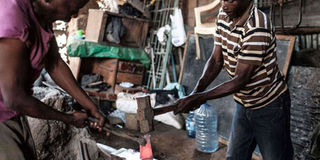Are we becoming richer than we thought, or is this ‘statistics’?

George Ochieng (right) and Onyango Owino work at their Jua Kali shed in Kibera, Nairobi on October 4, 2017. PHOTO | YASUYOSHI CHIBA | AFP
What you need to know:
- The unemployment rate has dropped from 12.7 per cent to 7.4 per cent over the period.
- In the absence of regular and updated data, our policy makers literally fly blind when designing policy.
- KNBS has just announced that the census that it plans to conduct in August will be preceded by cartographic mapping.
According to the recently published ‘Kenya Integrated Household Budget Survey’ report by the Kenya National Bureau of Statistics (KNBS), the incidence of poverty has been trending downwards in the past 10 years.
Inequality within the Kenyan society is also reducing. And the unemployment rate dropped from 12.7 per cent to 7.4 per cent over the same period.
But where is the wealth these statisticians are a seeing and measuring in this country?
We all still remember that memorable quote attributed to former British Premier Benjamin Disraeli and popularised by Mark Twain that goes: “There are three kinds of lies, damn lies and statistics.”
Statistics is supposed to be an exact science. Are the statisticians giving us damn lies? I don’t know.
STATISTICS
Granted, the KNBS has the largest repository of trained economists and statisticians in the country. The problem is that the people in power don’t regard statistics highly.
In some jurisdictions, national statistical offices enjoy as much independence as the Central Bank.
Just how low data and statistics are regarded by policymakers here was demonstrated in the last Cabinet structure, where our statistics office was placed under the Devolution and Planning Ministry — lumping it with several unrelated departments, including graft-riddled departments such as the National Youth Service (NYS) and the Youth Enterprise Fund.
In some countries, national statistics offices conduct household surveys — not only frequently, but also continuously. Here, industrial surveys and labour market reviews are done infrequently.
In the absence of regular and updated data, our policy makers literally fly blind when designing policy.
PUBLIC OUTRAGE
Last time, there was public outrage when census figures showed that the population of (now defunct) North Eastern Province had increased by 104 per cent within 10 years. In the ensuing furore, the results in some districts were cancelled.
The KNBS has just announced that the census that it plans to conduct in August will be preceded by cartographic mapping. This is a good thing because more use of technology will help KNBS to improve data quality.
With the explosion of mobile telephony, it’s only a question of time before the people become regular respondents in censuses and other surveys.
It is possible to use satellite imagery to literally see and gauge — from Outer Space — economic activity on highways, in ports and markets.
UNEMPLOYMENT
Tracking what people do, search or talk about on the Web can give you a picture of what they are engaged in. Still, what I find intriguing is how they come up with the numbers on unemployment. What constitutes a job in an urban economy that is informalising in very complex ways?
Does that able-bodied man who walks around Nairobi bars hawking secondhand clothes go into the books as employed? How about that hawker who walks along Uhuru Highway the whole day, his only stock in trade, fake Chinese hi-fi equipment and mobile phone accessories?
The jua kali sector is a place labour turns to only when the alternative is worklessness. These are just disguised forms of unemployment.
Yet, if you took random samples of the typical worker sitting in a matatu going to work in Nairobi, the majority will be hair stylists, fitness instructors, disco hall bouncers, cleaners, house-helps, watchmen, secondhand clothes hawkers and the workers in the car wash bays and kiosks.
SERVICES STALLS
A far greater majority will be jua kali mechanics, workers in M-Pesa outlets, employees of call centres, mobile telephone repair shops or photocopying and document binding services stalls.
Within the central business district, the formerly ubiquitous duka — as shops owned by Kenyans of Indian extraction were popularly known — are fast being supplanted by 10-by-10 so-called “exhibition” stalls selling uncustomed clothes, footwear, mobile phones and computers — which, invariably, will have been imported through Kismayu Port or Eldoret International Airport. Today, even the smallest urban area has a “Garissa Lodge” — jargon for such shops.
INFORMAL ECONOMY
But how many workers are employed in this informal economy and what wages do they earn? Clearly, the Integrated Household Budget Survey has painted too rosy a picture of living conditions.
We need to strengthen and fund the KNBS. And, for a start, can we rehabilitate or rebuild Herufi House — that derelict building that sticks out like a sore thumb between The National Treasury and the Central Bank of Kenya as if the sole purpose of its presence is to remind us that statistics is not important?





